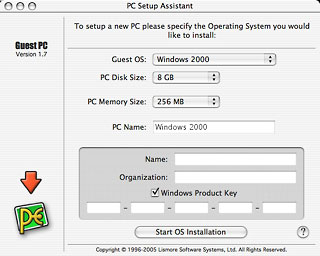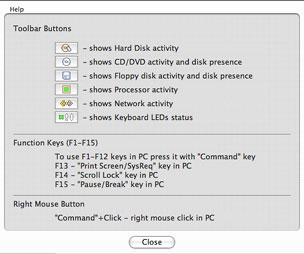With Microsoft Windows 20 years old this past November, I guess it's
time to admit that we'll probably have to deal with Windows for a
while. And like many Mac users, I sometimes have to work with
Windows applications or files that don't seem to have any usable
Mac alternatives.
For some of us that may be a Windows-based accounting program.
Or Microsoft Access database files. (Yes, there are Mac accounting
programs and FileMaker Pro,
but these are not always usable as
alternatives).
My wife's workplace long ago standardized on the Quattro-Pro
spreadsheet. She's not willing to save-as Excel, then import the
modified Excel files back into Quattro-Pro when she brings files
home from work.
My daughter can register for university online - but only using
a Windows version of Internet Explorer.
In these cases and others, rather than fuss with file conversion
(if possible, which isn't always the case), it's sometimes easiest
to bow to the inevitable and run the Windows program. But you may
not need (or want) to do so on an actual Windows PC; in many cases
you can do what you need on an emulated Windows PC running in a
window (note the small "w") on your Mac.
For a number of years the standard PC emulation software has
been Virtual PC (VPC), originally developed by longtime Mac utility
developer Connectix. It was purchased a few years ago by Microsoft,
which now sells VPC on its own or as part of a bundle with the Mac
version of Microsoft Office. (Microsoft was probably more
interested in buying VPC for its PC version, which lets Windows
users run multiple PC operating systems at once on a single system.
They're busy integrating this capability into their Windows Server
software).
But Virtual PC isn't the only way to emulate a PC (Windows or
otherwise) on a Mac. Despite rumours of its revival, SoftPC seems
to be gone for good. But a newcomer from Russia's Lismore Software
Systems named Guest
PC has taken up the challenge. Guest PC is available as a 3.8
MB download at a more attractive price than Virtual PC: US$69.99
buys a family license that's good for all the Macs in your
household.
Unlike VPC, which is sold at a variety of prices bundled with a
variety of Windows operating systems, you'll need access to your
own copy of Windows for use with Guest PC. And where VPC bundles
its various versions of Windows as preinstalled image files, with
Guest PC you need to go through the time and effort of actually
installing your desired Windows version from scratch.
A time saving tip: Use your Mac's Disk Utility to
create an Image File from your Windows install CD onto your
desktop. Guest PC will be able to install from the image file, and
installation will be much quicker than installing from the
physical CD.
Guest PC does some cute tricks during the installation. When you
choose a Guest OS version, it proposes a virtual disk size and
memory size (you can change these defaults) and gives you the
option to enter your name, organization, and Windows product key.
These are entered into a setup script and are automatically entered
during the Windows installation procedure.
Your Mac's default printer is emulated as an Apple LaserWriter
that Windows thinks is connected to a nonexistent parallel port.
The install script even sets your default Internet Explorer home
page to Lismore System's website.
 Like Virtual PC, Guest PC users can install an optional set
of "Additions" after starting up Windows. These make it possible to
smoothly move back and forth between the Windows cursor and the Mac
cursor, to drag and drop and to copy and paste between the two
environments, and more.
Like Virtual PC, Guest PC users can install an optional set
of "Additions" after starting up Windows. These make it possible to
smoothly move back and forth between the Windows cursor and the Mac
cursor, to drag and drop and to copy and paste between the two
environments, and more.
I tested Guest PC version 1.7 on two Macs: a nearly current
iMac 1.8 GHz G5 with 1.5 GB
of RAM and a two year-old 800 MHz
iBook G4 with 640 MB of RAM. The amount of RAM is crucial - you
need enough physical memory installed on your Mac so that you can
reserve a reasonable amount for your virtual PC while still leaving
enough for your Mac to continue to function.
Even devoting a reasonable 512 MB of RAM to it, I found Windows
XP too slow. This is not particularly a criticism of Guest PC;
WinXP runs equally sluggishly under Virtual PC. Windows 2000 (with
256 MB of RAM) was much more usable, and Windows 98SE (with a
humble 128 MB of RAM - up from Guest PC's suggested 64 MB) was
perkier still.
My suggestion: Install the oldest Windows operating system that
will work with your needed applications. Guest PC performance was
comparable to Virtual PC performance (at least after the longer
Windows installation process), but both are slower than having a
real, physical PC.
Virtual PC offers limited USB support - and in some cases, but
not all, you may be able to make use of USB devices plugged into
your Mac. Lismore is working on USB support, but it's not available
yet.
A set of toolbar buttons below the Guest PC window show disk,
CPU, and network activity and allow access to keys and key
combinations (like PRNTSCRN or Control - Alt - Del) that are hard
to do on the Mac keyboard. Clicking the '?' toolbar icon shows the
meaning of these buttons along with several other hints (such as
holding down the Command key to right-click using a single-button
mouse)
 Guest PC includes a minimalist DOS environment (using a
non-Microsoft version of DOS). It can be used with non-Windows PC
operating system, though these do not get the same level of
installation-script support and lack the post-installation
Additions. (Tip: Press Command - Option if needed to get your mouse
cursor back).
Guest PC includes a minimalist DOS environment (using a
non-Microsoft version of DOS). It can be used with non-Windows PC
operating system, though these do not get the same level of
installation-script support and lack the post-installation
Additions. (Tip: Press Command - Option if needed to get your mouse
cursor back).
I installed my current favourite Linux distribution, Ubuntu. It
worked (though slowly) with Guest PC. I'd been unable to make it
work at all with Virtual PC.
One nice feature of VPC that isn't in Guest PC (at least not
yet): VPC lets you shut down the PC window, saving the current
memory contents to a file on your hard drive. Restarting that saved
PC simply opens that file, restoring it to its former state (along
with its former time). That Fast Save can be a big time-saver over
needing to reboot your emulated computer each time; hopefully
Lismore will add this to an upcoming version.
In Guest PC's favour: Sound and video both seem smoother than in
VPC systems.
Neither emulation supports 3D video acceleration, so if you're
hoping to use one or the other to play high-end Windows games,
don't bother.
But for a Mac user with a limited need for an individual Windows
application - like my wife's need for Quattro Pro or my daughter's
need to register for school using Internet Explorer, Guest PC works
fine (particularly using Windows 98). And being able to purchase a
single US$69 license for all of my family's Macs is much
appreciated.
When Apple's new models running on Intel processors come
on-stream in 2006, the task of running PC applications will change;
it may be possible to setup these models to multi-boot between Mac
OS X and other PC operating systems. In any event, it should
be less of a challenge to "emulate" a PC on a system running on an
Intel processor.
For users running a G3, G4, or G5 Mac but needing limited access
to a PC application, Guest PC does a good job - as long as you can
provide your own copy of a PC operating system. 

 Like Virtual PC, Guest PC users can install an optional set
of "Additions" after starting up Windows. These make it possible to
smoothly move back and forth between the Windows cursor and the Mac
cursor, to drag and drop and to copy and paste between the two
environments, and more.
Like Virtual PC, Guest PC users can install an optional set
of "Additions" after starting up Windows. These make it possible to
smoothly move back and forth between the Windows cursor and the Mac
cursor, to drag and drop and to copy and paste between the two
environments, and more. Guest PC includes a minimalist DOS environment (using a
non-Microsoft version of DOS). It can be used with non-Windows PC
operating system, though these do not get the same level of
installation-script support and lack the post-installation
Additions. (Tip: Press Command - Option if needed to get your mouse
cursor back).
Guest PC includes a minimalist DOS environment (using a
non-Microsoft version of DOS). It can be used with non-Windows PC
operating system, though these do not get the same level of
installation-script support and lack the post-installation
Additions. (Tip: Press Command - Option if needed to get your mouse
cursor back).
